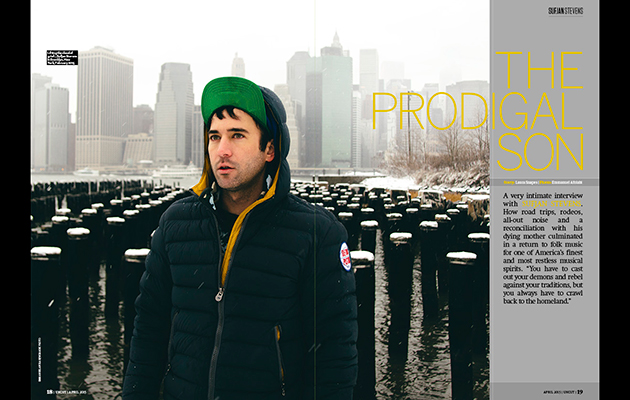To coincide with Sufjan Stevens' current run of American tour dates, here's our extensive interview with Stevens from Uncut's June 2015 issue. ---------- https://www.youtube.com/watch?v=3vj9s0U2U2o The Prodigal Son A very intimate interview with Sufjan Stevens. How road trips, rodeos, all-ou...
In December 2012, Stevens’ aunt called to say that his mother had cancer. “‘Carrie’s in the ICU, she’s probably not gonna live, if you wanna see her this is your last chance’,” he recalls. He had a few days with her in hospital before she died.
The youngest of six, Stevens and his siblings grew up with his father and step-mum after his mother left when he was one. Over the next few years, they only saw her when they visited their yia-yia and pappou in Detroit, until she married her high school sweetheart Lowell Brams when Stevens was five. The kids spent three summers with the couple in Eugene, Oregon, in the early 1980s, her most stable period.
“She was a good mother when she had her facilities together,” Stevens says. “And she had nothing but love for us and the best intentions. But she was really sick. She was very dysfunctional and she had substance-abuse problems – she was an alcoholic and a drug addict – and schizophrenic, bipolar, really depressed. We were aware of that, even as children. So we were very grateful for the limited time that we had with her, and we knew that it was finite. We had no delusions or expectations.”
When Stevens was seven or eight, Carrie and Lowell split. “We didn’t see her for a long time after that – she was off the map,” Stevens says, offering a broad assessment of what she did next: “Not good things.” As an adult, they occasionally met for lunch. “But outside of a few letters, we didn’t see each other that much. And I didn’t make an effort to see her. Why? That’s a good question for therapy.
“They talk about the stages of grief,” he says, wearily. “You go through denial and anger and depression, acceptance – there’s these so-called patterns. But I found myself experiencing inexplicable and uncategorisable kinds of emotional states that were so far removed from these traditional patterns of bereavement. Resentment. Anger. Disappointment.”
He pauses. “Shame.”
For not having tried to communicate with her? “No, ashamed of her.”
Stevens doesn’t want to talk about this record, but sees it as a professional duty – his success underwrites the existence of his record label, Asthmatic Kitty, which has nine employees. He evades eye contact but talks about his grief with disarming candour, and only refuses two questions: one about his love life, and the other about a lyric in the title-track, “She breaks my arm”, when asked if it relates to his mother.
The line is barely noticeable, a concealed spine in the song’s whispered banjo flutter. It’s emblematic of Carrie & Lowell’s aesthetic: profoundly heartbreaking, beautiful finger-picked folk songs that shroud gut-wrenching truths about love, death and abandonment. “Fourth Of July” traces the terrible intimacy of a hospital deathbed. “No Shade In The Shadow Of The Cross” is a portrait of self-destruction. “No reason to live”, he sings on “Should Have Known Better”. Asked whether the abusive relationship described in “Drawn To The Blood” was his own, he simply answers, “yes.”
“I found myself kind of feeling like my mother’s ghost was inhabiting me,” he says. “I had a lot of pretty dark moments. Oh god, it’s over though, I’m so glad it’s over.”
“The Only Thing” marks both the nadir of Stevens’ emotional state during that time, and the first sign of light: “The only thing that keeps me from cutting my arm/Cross-hatch, warm bath, Holiday Inn after dark/Signs and wonders: water stain writing the wall/Daniel’s message, blood of the moon on us all”.
He slowly recovered by letting in “small encounters of hope in very necessary doses,” he says: prayer, his young niece, the bike tours he took across America, staying in tents, hotels or his car, and cycling vast, solitary routes by day. “I went over North Dakota and Montana and Wyoming. And then eastern Oregon and eastern Washington were really unfamiliar and exciting to me because of how empty and vast and beautiful it was. I had my guitars with me so I wrote and recorded on that road trip.”
He travelled cross-country to see friends with studios, who inadvertently became part of Carrie & Lowell. There was no clear plan. “I was just travelling a lot and working with other people because it was convenient and I wanted engage socially lest I lose myself in isolation. A lot of those people and their participation, it really fed me, fuelled me, encouraged me.”
Bella Union solo artist Laura Veirs recalls his impromptu visit to her hometown of Portland about 18 months ago. They had met in 2005, when he asked her to support on the Illinois tour. “It was just one song, one hour, and then he left. He did not tell me anything about them. There were a couple of references to the state of Oregon, but that’s all I can say.”
In August 2013, Stevens travelled to Eau Claire, Wisconsin, to see Brian Joseph, who had been his live sound engineer and now works in Justin Vernon’s April Base studio. There he played with Casey Foubert, Ben Lester, and Sean Carey, who drums with Bon Iver and releases solo albums on Jagjaguwar as S Carey.
“It’s a pretty small town so you often end up recording on things that are sort of spontaneous,” says Carey. “When we got there Sufjan was out so we started working and when he came in we worked for a little while before we even stopped and introduced ourselves. As the night got on it got looser and it was really fun. We recorded all night – I got home at 5am.”



